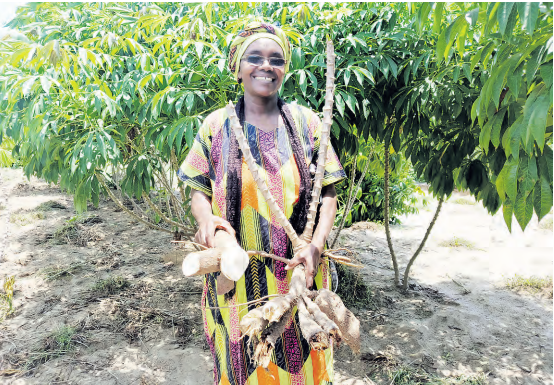
Janet Mwangala, a farmer from Mtepeni, Mtwapa in Kilifi county, has successfully cultivated cassava on her one-acre farm for the past four years.
Initially, she planted conventional cassava varieties that were susceptible to diseases.
However, after transitioning to hybrid cassava, she has observed a significant improvement.
To minimise disease risks, the farmer was advised to purchase clean cuttings from Kalro Mtwapa instead of from neighbouring farms.
“I ensure I plant clean cuttings sourced from the Kenya Agricultural and Livestock Research Organisation, which have proven to be much better,” Mwangala explained.
“If you plant cassava cuttings that are not clean, you risk harvesting crops affected by diseases.”
Mwangala previously grew maize but has since expanded her cassava cultivation.
Cassava takes about eight months to mature, while maize only takes three months.
To plant one acre of cassava, about 4,000 cuttings are needed, with each cutting costing Sh5, amounting to a total investment of Sh20,000.
Despite the costs, many farmers opt to borrow cuttings from neighbours, which can lead to disease problems.
“This approach is risky because the borrowed seedlings may not be disease-free. From my experience, investing in clean cuttings is essential for achieving a good harvest.”
The Tajirika improved cassava variety, which Mwangala grows, yields about 10 kilogrammes per plant.
Depending on market conditions, a kilogramme can sell for between Sh10 and Sh25.
“If you plant 4,000 cuttings, with each plant yielding 10 kilogrammes, you can earn between Sh1,000 and Sh2,500 per tree.
This represents a solid return on investment,” she said.
Mwangala pointed out challenges such as limited land availability and the prevalence of diseases, such as the cassava mosaic disease and brown streak.
Using clean plant cuttings can help mitigate these issues.
Dr Paul Kuria, a cassava breeder at Kalro, said cassava is a staple crop that can serve as a substitute for cereals which are affected by diseases like maize lethal necrosis and pests such as the fall army worm.
Cassava is primarily cultivated in the Coastal, Central and Western regions.
Kuria said viral diseases, particularly the mosaic and cassava brown streak, pose significant threats.
While Kalro has developed conventional breeding methods for mosaic disease resistance, sources of natural resistance for brown streak disease are lacking.
“To address this challenge, we are employing genetic modification,” he explained.
At Kalro- Mtwapa confined field trial site, researchers have combined conventional breeding with genetic modification to create varieties resistant to viral diseases.
“We have undergone multiple breeding cycles over the past decade, ensuring the safety of our varieties for humans and the environment,” Kuria said.
Kalro has collaborated with farmers, policymakers and regulators like the Kenya Plant Health Inspectorate Service to ensure the successful development of these new cassava varieties.
The researchers have seen improved yields and recently conducted the first season of national performance trials.
They are preparing for a second season, anticipating that the new varieties will be available to farmers by the end of 2025, provided all legal challenges are resolved.
Kuria added that the new cassava
varieties are derived from selections
that address farmers’ needs, focusing on yield, harvesting ability, plant
architecture and cyanide content.










